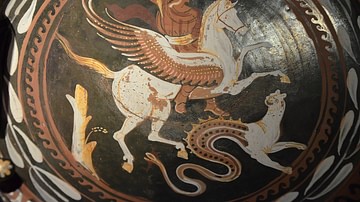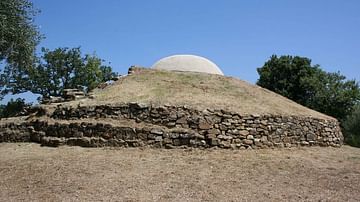The Chimera of Arezzo is a bronze statue sculpted by the Etruscans of northern and central Italy during the 5th-4th century BCE. The creature is the fire-breathing monster from Greek mythology which has the head of a lion, tail of a snake, and a goat's head protruding from its back. The menacing statue was discovered in Arezzo in Tuscany, Italy and is often cited as the finest example of Etruscan art. It is now one of the star pieces in the National Archaeological Museum of Florence.
The Chimera in Mythology
In mythology, the fire-breathing monster Chimera (also spelt Chimaera or Chimaira) was the offspring of Typhon and Echidna (both themselves half-snake, half-human monsters). In other versions, it was reared by Amisodarus. The Chimera was eventually killed by the hero Bellerophon, a seemingly impossible challenge set him by Iobates, the king of Lycia (on the instigation of his brother King Proetus of Tiryns). The son of Poseidon, helped by his winged horse Pegasus, fatally stabbed the monster with his spear. Mythological subjects, and animals especially, were a popular subject in Etruscan art and, in particular, bronze work.
Discovery
The Chimera statue was discovered in 1553 CE when fortifications were being built in the city of Arezzo (ancient name: Arretium) during the rule of Cosimo de' Medici, the Grand Duke of Tuscany. It was excavated in a trench along with other votive offerings such as small figure statues near the Porta San Lorentino. In 1566 CE the works revealed another fine Etruscan statue, the 'Orator.' So impressed was Cosimo with the Chimera figure that he adopted it as a symbol of his reign.
Features & Purpose
The life-size creature stands 78.5 cm (31 inches) high and measures 129 cm (50 ¾ inches) in length. It was cast in bronze, using the lost wax technique. It strikes a tense pose, almost ready to pounce on its victim as its rear end crouches ready for the spring and its claws are fully extended. The lion head has a mane of layered triangular points which match the hairy spikes along its back to complete the look of bristling menace. The goat's head protruding from its back lurches to one side from a bleeding wound while the snake tail, too, has fangs at the ready, even if this latter part is the product of a restoration carried out in the 18th century CE based on a surviving fragment. Another bleeding wound is found on the creature's rear leg.
The piece was probably part of a larger composition which included Bellerophon and Pegasus, hence the bleeding wounds. There is an inscription, incised into the wax during the casting process, on the front right leg which reads tinscvil or 'gift to Tin', indicating that it was intended as an offering to the god Tin (aka Tinia), the supreme deity of the Etruscan pantheon, either to persuade the deity to give help or in thanks for aid already given. Votive offerings were left at sacred altars at temple sites or even buried, perhaps explaining the miraculous survival of this fine Etruscan statue.






